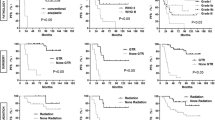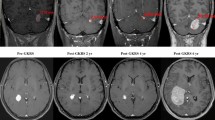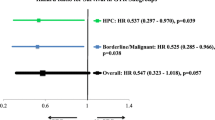Abstract
Background
Solitary fibrous tumor (SFT) is a rare mesenchymal tumor with an intermediate tendency to metastasize. Meningeal hemangiopericytoma (HPC), arising in the meningeal membranes, also is considered an SFT. Although SFT is assumed to show an unpredictable behavior, the authors defined some factors associated with its aggressive behavior.
Methods
This retrospective study was based on the medical records of 81 SFT patients treated surgically, with the median follow-up period of 59 months. The patients were assigned to three histopathologic groups based on the 2016 WHO classification: group 1 (SFT, 29 patients), group 2 (cellular SFT/hemangiopericytoma [HPC], 27 patients), and group 3 (malignant SFT/anaplastic HPC, 25 patients).
Results
The SFT histopathologic classification was associated with distant metastasis (DM) (p = 0.007). The multivariate analysis showed that cellular SFT had an independent impact on DM (odds ratio [OR] = 25.42; p = 0.006). Tumor diameter larger than 7.25 cm was correlated with DM (p = 0.010) and the patient’s disease-specific death (DSD) (p = 0.007). A 1-cm increase in tumor diameter enhanced the likelihood of metastasis by 1.26 (OR = 1.26; 95% confidence interval [CI], 1.05–1.53). Tumors originating from the central nervous system (CNS) showed a greater tendency toward local recurrence (LR) (p = 0.039) and DM (p = 0.05). Radiotherapy had no association with LR, DM, or DSD. The 10-year disease-specific survival rate was 82.7%.
Conclusions
Tumor size and histopathologic diagnosis are the predictors of SFT’s aggressive behavior. Cellular SFTs behave as aggressively as the malignant form of the tumor. A SFT grading based on SFT cellularity would contribute to anticipation of its aggressive behavior.



Similar content being viewed by others
References
Klemperer P, Rabin CB. Primary neoplasms of the pleura: a report of five cases. Am J Ind Med. 1992;22:4–31.
Fletcher CD, Unni KK, Mertens F. Pathology and Genetics of Tumours of Soft Tissue and Bone. vol 4. Iarc, Lyon, France, 2002.
Stout AP, Murray MR. Hemangiopericytoma: a vascular tumor featuring Zimmermann’s pericytes. Ann Surg. 1942;116:26.
Louis DN, Perry A, Reifenberger G, et al. The 2016 World Health Organization classification of tumors of the central nervous system: a summary. Acta Neuropathol. 2016;131:803–20.
Yoshida A, Tsuta K, Ohno M, et al. STAT6 immunohistochemistry is helpful in the diagnosis of solitary fibrous tumors. Am J Surg Pathol. 2014;38:552–9.
Robl R, Carvalho VO, Abagge KT, et al. Multifocal congenital hemangiopericytoma. Pediatr Dermatol. 2017;34:e69–73.
Tani E, Wejde J, Åström K, Wingmo IL, Larsson O, Haglund F. FNA cytology of solitary fibrous tumors and the diagnostic value of STAT6 immunocytochemistry. Cancer Cytopathol. 2018;126:36–43.
DeVito N, Henderson E, Han G, et al. Clinical characteristics and outcomes for solitary fibrous tumor (SFT): a single-center experience. PLoS ONE. 2015;10:e0140362.
Doyle LA, Fletcher CD. Predicting behavior of solitary fibrous tumor: are we getting closer to more accurate risk assessment? Ann Surg Oncol. 2013;20:4055–6.
Demicco EG, Park MS, Araujo DM, et al. Solitary fibrous tumor: a clinicopathological study of 110 cases and proposed risk assessment model. Mod Pathol. 2012;25:1298–306.
Gholami S, Cassidy MR, Kirane A, et al. Size and location are the most important risk factors for malignant behavior in resected solitary fibrous tumors. Ann Surg Oncol. 2017;24:3865–71.
Fletcher C, Bridge J, Lee J. Extrapleural solitary fibrous tumour. In: World Health Organisation Classification of Tumours of Soft Tissue and Bone: IARC Press, Lyon, 2013, pp 80–82.
Demicco EG, Wagner MJ, Maki RG, et al. Risk assessment in solitary fibrous tumors: validation and refinement of a risk stratification model. Mod Pathol. 2017;30:1433–42.
Demicco EG, Griffin AM, Gladdy RA, et al. Comparison of published risk models for prediction of outcome in patients with extrameningeal solitary fibrous tumour. Histopathology. 2019;75:723–37.
Ronchi A, Cozzolino I, Marino FZ, et al. Extrapleural solitary fibrous tumor: a distinct entity from pleural solitary fibrous tumor: an update on clinical, molecular, and diagnostic features. Ann Diagn Pathol. 2018;34:142–50.
Jia Q, Zhou Z, Zhang D, et al. Surgical management of spinal solitary fibrous tumor/hemangiopericytoma: a case series of 20 patients. Eur Spine J. 2018;27:891–901.
Gold JS, Antonescu CR, Hajdu C, et al. Clinicopathologic correlates of solitary fibrous tumors. Cancer. 2002;94:1057–68.
Ozturk R, Arikan SM, Simsek MA, Ozanlagan E, Gungor BS. Management of solitary fibrous tumors localized in extremity: case series and a review of the literature. Eklem Hastalik Cerrahisi. 2017;28:121–7.
Bishop AJ, Zagars GK, Demicco EG, Wang W-L, Feig BW, Guadagnolo BA. Soft tissue solitary fibrous tumor: combined surgery and radiation therapy results in excellent local control. Am J Clin Oncol. 2018;41:81–5.
Haas RL, Walraven I, Lecointe-Artzner E, et al. Extrameningeal solitary fibrous tumors–surgery alone or surgery plus perioperative radiotherapy: a retrospective study from the global solitary fibrous tumor initiative in collaboration with the sarcoma patients. EuroNet. 2020;126:3002–12.
Acknowledgment
We thank Dr. Leila Seddigh for her assistance in data analysis and Steven Salomon, MSc, for his assistance in collecting data and conducting this study.
Author information
Authors and Affiliations
Corresponding author
Ethics declarations
Disclosure
There are no conflicts of interest.
Additional information
Publisher's Note
Springer Nature remains neutral with regard to jurisdictional claims in published maps and institutional affiliations.
This study has been designed and accomplished at McGill University Health Center, Montreal, Quebec, Canada
Rights and permissions
About this article
Cite this article
Hassani, M., Jung, S., Garzia, L. et al. Aggressive Behavior Predictors in Solitary Fibrous Tumor: Demographic, Clinical, and Histopathologic Characteristics of 81 Cases. Ann Surg Oncol 28, 6861–6867 (2021). https://doi.org/10.1245/s10434-021-09592-w
Received:
Accepted:
Published:
Issue Date:
DOI: https://doi.org/10.1245/s10434-021-09592-w




